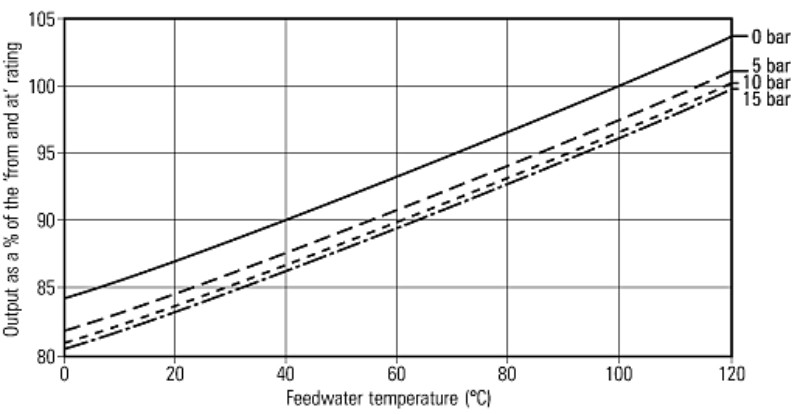Three types of boiler ratings are commonly used:
- 'From and at' rating.
- kW rating.
- Boiler horsepower (BoHP).
 Top
Top
'From and at' rating
The 'from and at' rating is widely used as a datum by shell boiler manufacturers to give a boiler a rating which shows the amount of steam in kg/h which the boiler can create 'from and at 100°C', at atmospheric pressure. Each kilogram of steam would then have received 2 257 kJ of heat from the boiler.
Shell boilers are often operated with feedwater temperatures lower than 100°C. Consequently the boiler is required to supply enthalpy to bring the water up to boiling point.
Most boilers operate at pressures higher than atmospheric, because steam at an elevated pressure carries more heat energy than does steam at 100°C. This calls for additional enthalpy of saturation of water. As the boiler pressure rises, the saturation temperature is increased, needing even more enthalpy before the feedwater is brought up to boiling temperature.
Both these effects reduce the actual steam output of the boiler, for the same consumption of fuel. The graph in Figure 3.5.1 shows feedwater temperatures plotted against the percentage of the 'from and at' figure for operation at pressures of 0, 5, 10 and 15 bar g.
 Fig. 3.5.1
Fig. 3.5.1
The application of the 'from and at' rating graph (Figure 3.5.1) is shown in Example 3.5.1, as well as a demonstration of how the values are determined.
Example 3.5.1
A boiler has a 'from and at' rating of 2 000 kg/h and operates at 15 bar g. The feedwater temperature is 68°C.
Using the graph:
The percentage 'from and at' rating ≈ 90%
Therefore actual output = 2 000 kg/h x 90%
Boiler evaporation rate = 1 800 kg/h
The use of Equation 3.5.1 will determine a factor to produce the same result:
Equation 3.5.1
Where:
A = Specific enthalpy of evaporation at atmospheric pressure.
B = Specific enthalpy of steam at operating pressure.
C = Specific enthalpy of water at feedwater temperature.
Note: These values are all from steam tables.
Using the information from Example 3.5.1 and the Equation 3.5.1 the evaporation factor can be calculated:
Therefore: boiler evaporation rate = 2 000 kg/h x 0.9
Boiler evaporation rate = 1 800 kg/h
 Top
Top
kW rating
Some manufacturers will give a boiler rating in kW. This is not an evaporation rate, and is subject to the same 'from and at' factor.
To establish the actual evaporation by mass, it is first necessary to know the temperature of the feedwater and the pressure of the steam produced, in order to establish how much energy is added to each kg of water. Equation 3.5.2 can then be used to calculate the steam output:
Equation 3.5.2
Example 3.5.2
A boiler is rated at 3 000 kW rating and operates at 10 bar g with a feedwater temperature of 50°C. How much steam can be generated?
Where, using steam tables:
Feedwater hf = 4.19 kJ/kg°C
Steam hg = 2 782 kJ/kg
 Top
Top
Boiler horsepower (BoHP)
This unit tends to be used only in the USA, Australia, and New Zealand. A boiler horsepower is not the commonly accepted 550 ft lbf/s and the generally accepted conversion factor of 746 Watts = 1 horsepower does not apply.
In New Zealand, boiler horsepower is a function of the heat transfer area in the boiler, and a boiler horsepower relates to 17 ft2 of heating surface, as depicted in Equation 3.5.3:
Equation 3.5.3
New Zealand
Example 3.5.3
A boiler has a heat transfer area of 2 500 square feet, how many BoHP is this?
USA and Australia
In the USA and Australia the readily accepted definition of a boiler horsepower is the amount of energy required to evaporate 34.5 lb of water at 212°F atmospheric conditions.
Example 3.5.4
A boiler is rated at 500 BoHP, what is its steam output?
Important: This is essentially the same as a 'from and at' rating, so using feedwater at lower temperatures and steam at higher pressures will reduce the amount of steam generated.
In practice: A BoHP figure of 28 to 30 lb / h would be a more realistic maximum continuous rating, taking into account the steam pressure and average feedwater temperatures.
A more practical result would then be:
Consequently: If 17 250 lb/h of steam is required, a 500 BoHP boiler would be too small, and the user would need to specify a boiler with a rating of:

